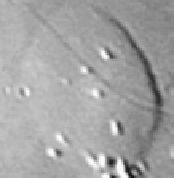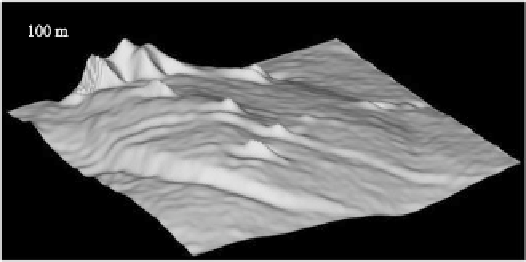Graphics Reference
In-Depth Information
Fig. 8.31
(
a
) Telescopic CCD image of the Valentine dome, situated at the western border of Mare
Serenitatis and possibly of intrusive origin. The image is rectified to perpendicular view, north is
to the top
and west
to the left
. Image credit: K.C. Pau. (
b
) Perspective view of the DEM of the
Valentine dome, viewed from northeastern direction. The vertical axis is 30 times exaggerated, the
curvature of the lunar surface has been subtracted
8.4.3.2 Error Estimation
According to the analysis by Wöhler et al. (
2006b
), three main sources of error
can be identified in the context of image-based three-dimensional reconstruction of
lunar domes based on photoclinometry and shape from shading (this analysis does
not refer to the method by Grumpe et al. (
2011
), which also relies on laser altimetry
data). The parameter
L(α)
of the reflectance function is not exactly known and may
show variations over the surface for different terrain types. A standard error of
L(α)
of 0
.
15 is assumed, an error range that also includes larger values of the macroscopic
surface roughness
θ
of up to 20
◦
(McEwen,
1991
, Fig. 16 therein). The radius
σ
of
the Gaussian PSF for the telescopic CCD images could be estimated at an accuracy
of about 0
.
5 pixel. The uncertainties in
L(α)
and
σ
affect the measured height values
of the lunar domes by no more than a few metres and can therefore be regarded as
irrelevant. The influence of the PSF can be expected to become more important for
strongly wrinkled surfaces.
A more important issue is the slight nonlinearity of the CCD sensor, which is
compensated by the gamma calibration procedure described in Sect.
8.2.2
. The un-
certainty of the determined gamma values approximately amounts to 0
.
05 for the
Atik and the ToUCam CCD cameras. The Lumenera CCD camera has a linear
(
γ
1
.
0) characteristic curve. The uncertainty in
γ
results in a relative standard
error of the dome height
h
of 10 %, which is independent of the height value itself.
The dome diameter
D
can be measured at an accuracy of 5 %, since the outer rim
is not well defined for most domes. Based on experiments, it is shown that these
uncertainties in
h
and
D
lead to a typical standard error of the edifice volume
V
,
computed by integration of the three-dimensional profile, of about 20 %.
Experiments regarding synthetic image data have shown that the proposed com-
bined photoclinometry and shape from shading approach does not produce system-
atic errors as long as the gamma value of the camera, the reflectance function, and
the PSF radius are known.
=











Search WWH ::

Custom Search